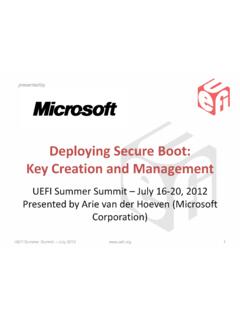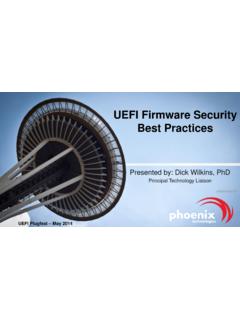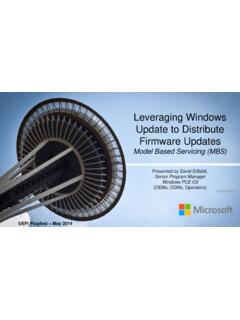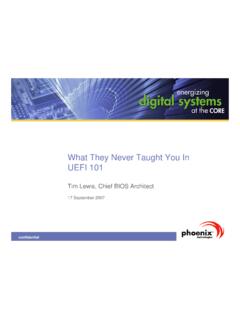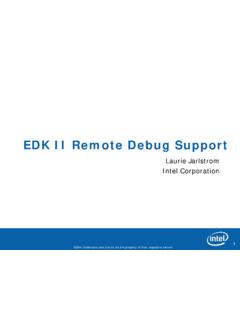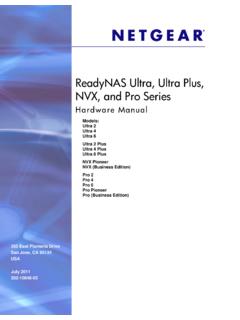Transcription of UEFI SECURE BOOT IN MODERN COMPUTER SECURITY …
1 UEFI SECURE boot IN MODERN COMPUTER SECURITY SOLUTIONS September 2013 Authors: Richard Wilkins, Phoenix Technologies, Ltd. Brian Richardson Intel Corporation OVERVIEW What is the UEFI Forum? The Unified Extensible Firmware Interface (UEFI) Forum is a world-class non-profit industry standards body that works in partnership to enable the evolution of platform technologies. The UEFI Forum champions firmware innovation through industry collaboration and the advocacy of a standardized interface that simplifies and secures platform initialization and firmware bootstrap operations. Both developed and supported by representatives from more than 200 industry-leading technology companies, UEFI specifications promote business and technological efficiency, improve performance and SECURITY , facilitate interoperability between devices, platforms and systems, and comply with next-generation technologies.
2 What is UEFI SECURE boot , and how did it originate? UEFI SECURE boot was created to enhance SECURITY in the pre- boot environment. UEFI Forum members developed the UEFI specification, an interface framework that affords firmware, operating system and hardware providers a defense against potential malware attacks. Without UEFI SECURE boot , malware developers can more easily take advantage of several pre- boot attack points, including the system-embedded firmware itself, as well as the interval between the firmware initiation and the loading of the operating system. Malware inserted at this point can provide an environment in which an operating system no matter how SECURE cannot run safely.
3 SECURE boot helps firmware, operating system and hardware providers cooperate to thwart the efforts of malware developers. Additional background on the intent of UEFI SECURE boot can be found in "UEFI Networking and Pre-OS SECURITY ," published in the Intel Technology Journal [1]. What are the most common misperceptions about UEFI and UEFI SECURE boot ? Several misperceptions about UEFI SECURE boot , its intended uses, requirements and application exist within the technology and end-user community. A few of the most common are outlined below and in greater depth throughout this paper. False: UEFI SECURE boot is an attempt to lock platforms to software from specific vendors and block operating systems and software from others.
4 False: UEFI SECURE boot requires a TPM chip, as described by the Trusted Computing Group (TCG), and TCG controls the UEFI specification. False: UEFI SECURE boot requires a specific implementation by COMPUTER manufacturers and operating system vendors. CONTENTS This paper discusses UEFI SECURE boot misperceptions and includes examples of potential malware attacks in the PC and non-PC space. It also provides history and examples of rootkit and bootkit attacks and outlines UEFI SECURE boot solutions. Below is a table of contents. The views and opinions of the authors do not necessarily reflect the views of Phoenix Technologies and Intel Corporation, or their respective affiliates.
5 Overview .. 2 Contents .. 2 Malware: From Simple Pranks to Sophisticated Threats .. 3 BIOS History and Emergence of UEFI specifications .. 3 The Advent of Rootkit and Bootkit Attacks .. 4 Attacks on Mobile Devices .. 5 Existing Firmware Protection .. 5 Proposed Solution .. 6 UEFI Specifications Utility When Executing boot Code .. 6 Management of Keys and Signatures in Code Execution .. 7 SECURE boot as an Optional Feature .. 7 Disabling SECURE boot .. 8 Trusted Signers .. 8 Beyond SECURE boot .. 8 Conclusion .. 9 References .. 10 MALWARE: FROM SIMPLE PRANKS TO SOPHISTICATED THREATS Malware, or COMPUTER code written for nefarious purposes, has transitioned from the experiments and pranks of the 1980s to the sophisticated tools used today to intimidate, reduce productivity, and steal sensitive personal, financial or business information.
6 As COMPUTER software developers have improved their resilience in the face of these attacks, malware developers have begun to target the firmware that starts up COMPUTER systems, focusing on the gap between the firmware and when the operating system starts. These are generally referred to as rootkit or bootkit attacks and will be explored in this paper. BIOS HISTORY AND EMERGENCE OF UEFI SPECIFICATIONS The firmware that initializes COMPUTER systems and loads an operating system is generally referred to as the BIOS (Basic Input/Output System). The term BIOS comes from the firmware developed for the IBM PC/XT in the late 1970s [2].
7 That code was developed in assembly language for 16-bit 8086/8088 Intel processors and was targeted for use in a few thousand PC units. Despite inherent design limitations, that firmware implementation has been adapted and expanded many times. In the late 1990s, Intel sought an alternative to BIOS for its new Itanium processor. Because the limitations of a 16-bit system caused problems on the newest 64-bit processor, the Extensible Firmware Interface (EFI) was developed as an alternative. The EFI design specified an interface between a firmware implementation on a hardware platform and on an operating system.
8 As a result, either the platform firmware implementation or operating system implementation could change, but remain independent, as long as they followed the EFI specification. Intel released the EFI version specification in 2002 [3]. The ownership of this specification was then transferred to the Unified EFI Forum, or UEFI Forum, a non-profit collaborative trade organization now made up of more than 50 promoting and contributing member companies and more than 200 adopting companies, formed to promote and manage the specification. In November 2010, the UEFI Forum released a version of the UEFI specification [4] that included facilities for substantially enhanced SECURITY when booting operating systems.
9 MODERN UEFI specifications provide a standard and extensible interface between the firmware and the operating system. Additional background on UEFI can be found in "Beyond BIOS: Exploring the Many Dimensions of the Unified Extensible Firmware Interface," in the Intel Technology Journal [5]. THE ADVENT OF ROOTKIT AND BOOTKIT ATTACKS Malware developers have increased their attempts to attack the pre- boot environment because operating system and antivirus software vendors have been hardening their code and limiting SECURITY attack vectors. The two primary types of attacks in the firmware space are known as rootkits and bootkits.
10 Malware hidden in the firmware is virtually untraceable by the operating system, unless a search specifically targets malware within the firmware. Malware in the firmware also has direct access to hardware components and can use Virtual Machine technology to compromise a system without the knowledge of the user or detection by the operating system. Moreover, some attacks attempt to implant themselves into the System ROM itself, meaning that if they succeed, they will persist even if the operating system is reinstalled or the hard drive is swapped out. Firmware rootkits inject exploit code into the system, either by patching or replacing the default firmware image.
